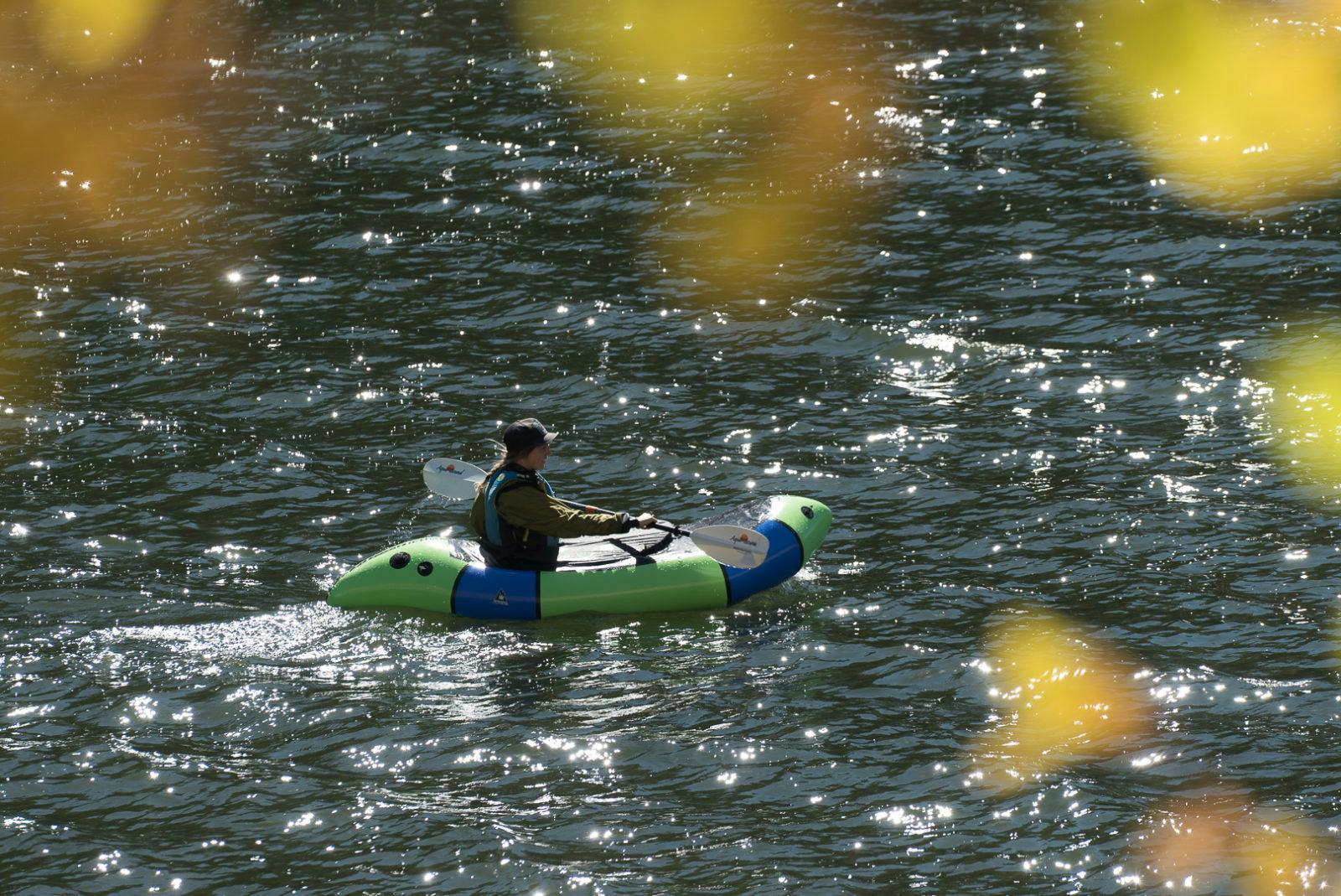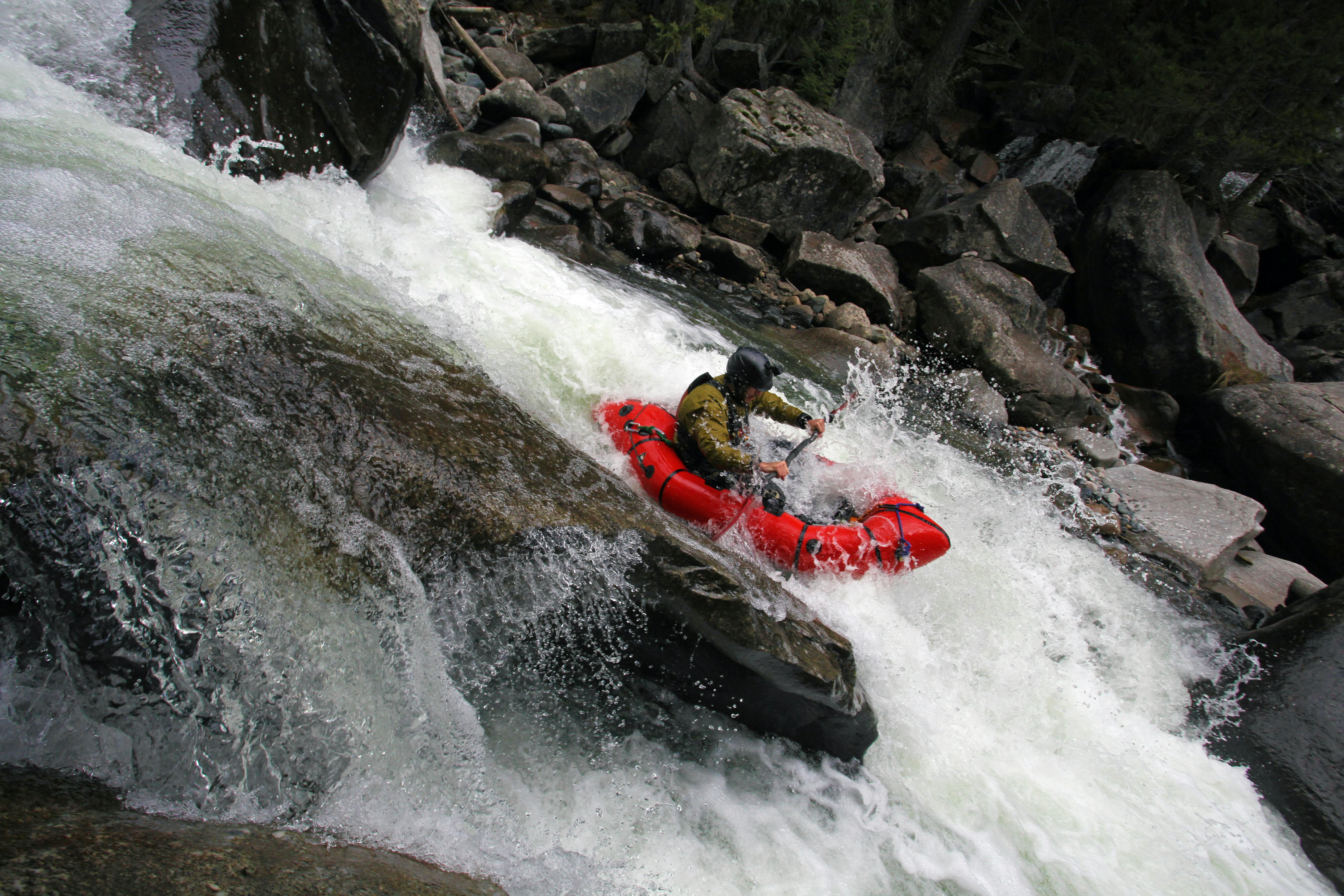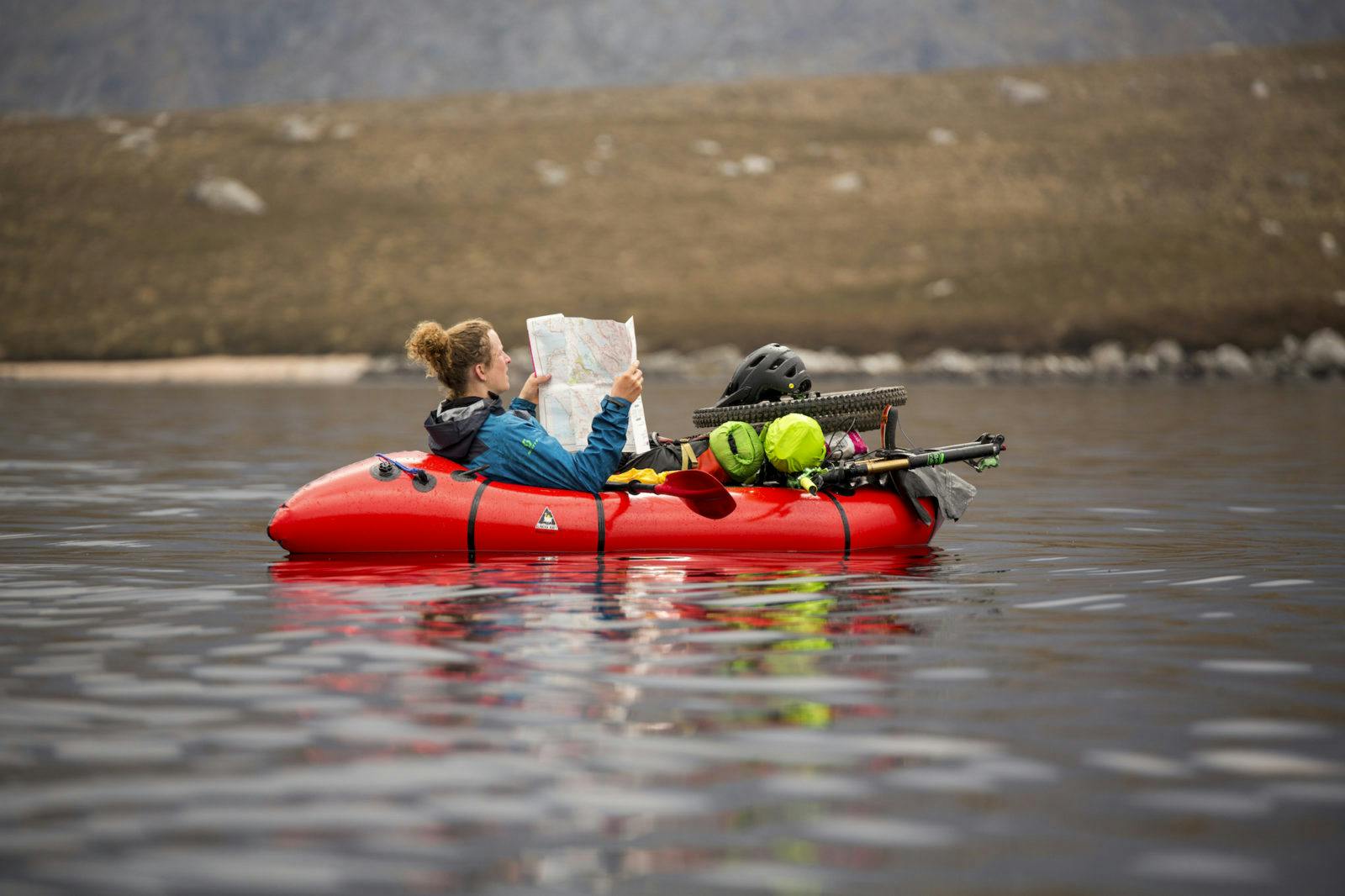How To Mitigate the Dangers of Packrafting
By Chad Oelke, cover shot by Mike Curiak
In the third of this three-part series, we explore ways to mitigate the dangers of packrafting through: acquiring paddling skills and quickly responding to hazards; how to gain experience and good judgement; common causes of accidents; and how to manage risk when running unknown water. Read part I and part II.
Packrafts have advanced rapidly in terms of materials, design, and capabilities. A little over a decade ago packrafts were considered simple tools to cross a river, or fish an alpine lake; now they drop waterfalls in Mexico and run Class V whitewater in the Grand Canyon. On the banks of a gin-clear river, cherry red and shining with a fresh coat of 303, your packraft may look like a chariot of the gods. But without the skills to drive that mighty chariot, you might end up with something more like a rubber ducky of the gods. Learning river running techniques and basic paddling skills will ensure your packraft always handles like a celestial hot rod.
Learning Paddle Strokes

Learning basics paddling techniques are essential to catch eddies, quickly avoid hazards, and of course, shred the proverbial gnar. Unfortunately, describing all the different strokes is beyond the word count of this article. Instead, “armchair paddling” on Youtube or Alpacka’s own packrafting video series are best ways to get acquainted with basic paddling strokes and maneuvers. You could watch Alpacka’s video for the killer reggae soundtrack alone. Instructional whitewater kayaking or canoeing videos on Youtube are also a great resource.
Quickly Responding to Hazards; Or, Pinballs & Paddles
On the surface, pinball and packrafting share little in common. Pinball machines live in the backroom of dingy pizza joints and dive bars. Packrafters live in the back of vans and Toyota pickups. Pinball machines haven’t left their corner of the arcade since 1987. Packrafters hike all over the world. But pinball and packrafting do share a few key similarities: both require quick-decision making and rapid hand-eye coordination.
Floating the Upper Green River in the Winds, you may have to constantly deal with different hazards: a sudden hole on river left, a strainer on river right, a grumpy beaver on a direct collision course at river center. Safely floating narrow wilderness creeks, where rapids or strainers can hide around every bend, requires continuous risk assessment and quick maneuvering. Anticipate where hazards will form, based on the character of the river, so that you can avoid them early. Learn the proper techniques to quickly ferry across river, catch an eddy, or square up to a wavetrain. Train hard and someday you may become a packraft wizard.
Experience & Judgement
Experience and judgement are slippery ideas to pin down. There is no clear metric for how much experience is “enough” or how experience translates into good judgement. The best way to build judgement is to gain a solid foundation of knowledge, skills, and perhaps most importantly, experience.
A Common Cause of Packrafting Accidents
Failed to tie up their boat during a lunch break. Boat is now floating somewhere in the Bering Sea.
Put-in at the wrong spot on a “Class II” river; boat flipped in an unexpected Class IV hole. Boat is now somewhere at the bottom of the Turnagain Arm.
Novice boaters were told a river was “safe” by an experienced boater. It was sunny summer day so they decided not to wear helmets. One of the boaters hit an easily avoidable rock, swam and ended up with a serious head injury. During the helicopter rescue that followed, another of the boaters was hit by rockfall caused by helicopter wash and ended up in a coma for three months.
What do these accidents have in common?
Inexperience is a major cause of packrafting accidents. For novice boaters, they simply may not know how to read the river or understand the risks inherent in running even a “safe” river. Experience helps us understand the consequences of swimming a rapid or danger of not properly securing our boat for the night. Experience can help us build the paddling techniques to ferry across strong currents to rescue a swimmer, or eddy out to scout an unknown canyon even though we heard there were “easy” rapids there. However, because of the wide range of conditions while packrafting, experience may not always enough.
Experience Can Be a Trap
A warning for packrafters: know-it-alls may not know it all. If you are planning a trip with someone you’ve never boated before you may ask: what rivers have you run? Or, what class of water are you comfortable with? The real question you are trying to answer: how good is your judgement?
Ask yourself: How much confidence do you have in your partner? That whitewater kayaker you met at the brewpub last night, who looked as bronzed and well-seasoned as a piece of KFC rotisserie chicken, do you think his definition of an “easy” Class II river is the same as yours? How many times do you remember him saying something called “the Gnar”? Be aware that boating skills and experience do not necessarily equate to good judgement.
Some whitewater kayakers may be superb athletes, but lack rescue training. As a less experienced boater, don’t be afraid to portage a rapid you are not comfortable running. That tribal-tattooed, kayaker bro who wants to charge the Class V waterfall may not be able to save you from a recirculating hole, or have the knowledge to help you survive a serious head injury if you pinball off a few boulders.
An experienced boater may have a great intuitive sense of the river, but lack situational awareness. Even the most grizzled demigoddess of the gnar may not notice a strainer hidden behind a rock, or see the antlers of a bull moose hiding behind a riverside patch of willows. Reserve a suspicion about “known” river beta and a healthy respect for the hazards of the unknown. Whether you are the Master of the Gnar or a first-time boater, speak up if you notice something. In short, learn to read water and rely on your own knowledge to assess risk, rather than blindly following your new kayaker over the falls or the lore written in some adventure blog.
How to Manage Risk When Running Unknown Water

In 2002, Donald Rumsfeld gave a (now infamous) speech about the possible presence of WMD’s in Iraq[i]. Rumsfeld, who actually borrowed the concept from NASA[ii], talked about the difference between known knowns, known unknowns, and unknown unknowns. Although the WMDs were obviously never found, Rumsfeld’s “known knowns” idea is an interesting way to conceptualize exposure to risk. This concept is useful for packrafting because we are often running rivers with significant hazards that are poorly known or even unknown.
As an example, let’s apply the “known knowns” idea of risk to a hypothetical run of the Sanctuary River in Denali National Park.
The known knowns: the river is about 20 miles from its headwaters to the take-out, Class I-II at normal water levels, and we may have a few route descriptions that will guide us to the put-in. You also know it’s a Tuesday in July, you have five days in Alaska, and the Reindeer sausage you ate from the food truck last night is definitely migrating—in a none too agreeable fashion—through your digestive track.
The known unknowns, or hazards that you can anticipate and prepare for: you heard there are “some” strainers on the river and know from NOAA that flows may increase from recent rains. You doubled checked that the bun was gluten-free, but was that really Reindeer in the sausage?
The unknown unknowns or hazards you can neither anticipate nor prepare for: on the morning of the put-in, a Grizzly mistakes your red packraft for a patch of soap berries and tears it to shreds; a freak Alaskan heat wave causes one of your group members to get heat stroke. Unbeknownst to you or the distinguished experts on WebMD, you are a medical anomaly with a rare allergy to Reindeer meat.
Here is an example of the danger of unknown unknowns. Let’s say you’ve run the Sanctuary River many times before and “know” it. You decide to run it again. Unbeknownst to you, a section of the Sanctuary just jumped a channel over the winter. What you remember last year as a mellow stretch of bird-watching water has suddenly become a harrowing gauntlet through the strainer-filled skeleton of a spruce forest. This kind of unknown unknown is something that you cannot directly prepare for, but nonetheless must anticipate. Before running a remote river, where your exposure to hazards may seem low but the consequences are high, think: Do you have the ability to confidently avoid known hazards hazards?
Good Judgement is Choosing Between Ice Cream Flavors
You arrive at a posh homemade ice cream shop in town you’ve never been before. You know you like walnuts, chocolate, and caramel. But do you get a scoop of Cherry Chocolate, Walnut Fudge, or Salted Caramel? Which ice cream flavor will maximize your pleasure and minimize your chance of wasting .50 on a single scoop? You may end up nervously sweating at the counter, weighing the benefits and costs of chewing walnuts, or probable saltiness of their Salted Carmel. Your friend said she liked the Cherry Chocolate, but then you don’t know if you like cherries. There may be no easy choice; eventually you decide to get two scoops (for of course) of two different flavors to hedge your bets. Of course, you should always try and think outside the box: the best option may have been to just go buy a beer.
In effect, ice cream selection and good judgement both involve optimizing your risk based on imprecise knowledge[iii]. In both cases, we are dealing with a wide range of unknown, or even unknowable, variables. On the river we may have to judge the river level, the potential for swim, possible escape routes or portages, the durability of our gear, and our partners’ whitewater ability in order to make a sound decision about running a Class IV canyon. We need to put all our knowledge, skills, and experience together to make the best possible choice given the fact that the consequences of our actions are unknown (or unknowable). There may often be no clear answer about which choice is “safest”. Portaging a Class III canyon may require a long, heinous bushwhack up cliffs of alder that will increase your chance for blowing out a knee or getting charged by a Grizzly. Scouting every bend around the river will significantly slow your travel, which may lead to floating the canyon at twilight when the rapids are harder to read. As a result, we need to be flexible and not focus on concrete rules about safety. Instead, the ultimate goal of learning about whitewater safety and gaining experience on the river is to build good judgement that allows us to understand the level of risk we are willing to take.
Conclusion

Risk is something we can never eliminate, only mitigate. If we focus too heavily on safety, we risk becoming overly cautious boaters whose development is stymied by fear of swimming an easy rapid or losing our favorite new carbon fiber paddle. If we completely ignore hazards and common sense boating, we risk breaking ribs after a bad swim in a Class IV boulder garden or losing our boat to a river-wide strainer. But in contrast to the tightly-controlled, safety obsessed environment of our daily lives, we should not avoid risk. Adventure entails risk, and if we eliminate it, we lose both the danger and possibilities of the unknown. Instead, we should find what we feel comfortable packrafting, whether that is doing a first descent in the Yukon or floating bubbly rifles on our local creek.
Knowing the basics of how hazards are formed, the limits of your gear, and your own paddling skills will help you build the judgement needed to understand your target level of risk as a packrafter. However, like any other serious sport, whether it is competitive Ping-Pong or the caber toss at the Scottish games, the more you learn, practice, and prepare, the better you will become. Read and run water where the consequences are low. Experiment with different gear, setups, and types of trips. Take a Whitewater Rescue Technician or Swiftwater Rescue Technician course to learn rescue techniques. Plan a packrafting trip without guidebooks, blogs, or brewpub beta to become more self-reliant. Finally, when you get ready for that ten-day trip to the Brooks Range you can confidently answer the question: am I prepared for the risks of this trip? Floating down the Alatna River at midnight, with the granite walls of the Arrigetch silhouetting an arctic sunset, you’ll realize it was a risk well worth taking.
This is the final in a three-part series on packraft safety by Chad Oelke. Chad first learned the value of swiftwater rescue during two seasons as a commercial raft guide. Recently, he has honed his safety skills working as a Backcountry Ranger for the NPS in Alaska. Although the sunny oak forests of Northern California are his native home, the author prefers the bog and brush of Interior Alaska to almost anywhere else on the planet. Besides packrafting, his hobbies also include kayaking, fly-fishing, and endlessly fixing his 91′ Toyota Pickup.
[i] U.S. Department of Defense (Producer). (2002, February 12). Retrieved from http://archive.defense.gov/Transcripts/Transcript.aspx?TranscriptID=2636
[ii] There are known knowns. (N.d.). In Wikipedia. Retrieved on September 17, 2017, from https://en.wikipedia.org/wiki/There_are_known_knowns.
[iii] Wilde, G.J.S. (2014). Target Risk 3: Risk Homeostasis in Everyday Life. Toronto, PDE Publications; Castor & Columbia.

